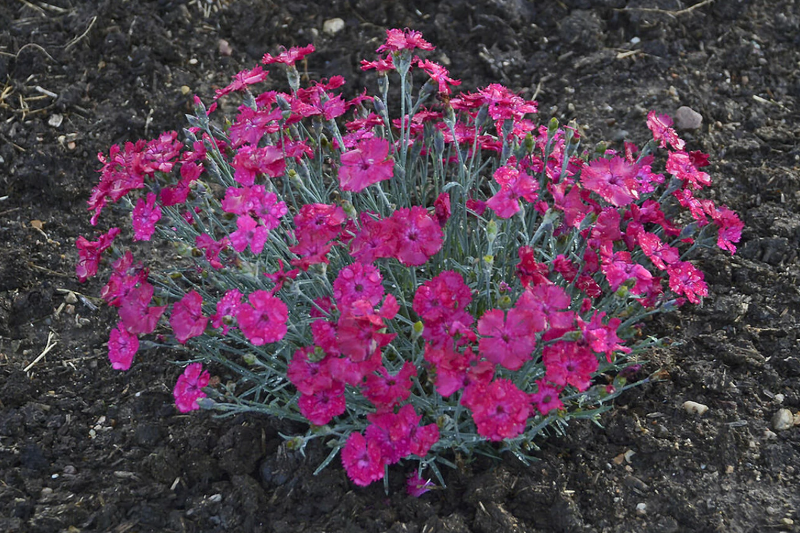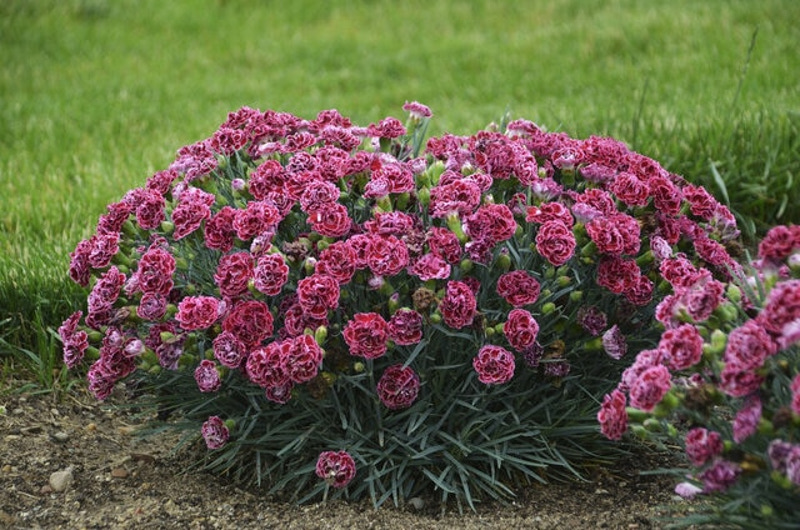Dianthus plants are pretty “cottage style” flowers that come in a variety of colors and sizes and are easy to care for. They attract birds to your garden and can also be grown in planters and window boxes. The scientific name is Dianthus spp. and a common nickname for the flowers is “pinks.” This is due to the fact that they are often a pretty shade of pink but also their petals look like they have been clipped with pinking shears.

Dianthus are in the same family as the carnation and have a sweet and spicy scent that is sure to please any flower lover. The flowers are also edible and can be used in baking and creating teas. They attract birds to your yard and are deer resistant. If you are looking for a small pretty groundcover or plant to compliment your other garden flowers, dianthus is one that should be considered.
What You Need To Plant Dianthus
To plant dianthus you do not need any special equipment. Common garden trowels and shovels work to dig holes and a garden hose or watering can be used to water young plants. If you are planting from seed you may need a light garden hoe or trowel. The use of a slow release fertilizer is recommended. If you feel your garden soil could use some amending, you may want to mix in some compost or manure before planting and let it sit for a few days so that the young plant roots are not damaged.
Depending on the time of year that you are planting you may also want to add a layer of mulch to help slow down water evaporation and also slow down the spread of weeds around your plants.
Where to Plant Dianthus
Dianthus grow best in partial sun. Pick a location in your yard that will receive three to six hours of sunlight each day. The plants like rich garden soil that is a bit on the alkaline side with good drainage. A good test of this is to dig down to the root level and take a soil sample. You can have it tested at a local lab or do a quick at home test. To test the drainage of your chosen spot. Dig a hole and fill it with water, it should drain easily. If not, you may want to choose another location or amend your location. Plant young plants 6 to 18 inches apart.

Dianthus Spacing
Dianthus plants will spread and make a lovely ground cover or flower border for your yard. Plant them 6 to 18 inches apart depending on the variety. If you are not sure a good rule of thumb is to plant young plants and seeds 9 inches apart. They will quickly spread and fill in. If you feel your plants are too crowded they are easily divided. Just dig up and cut in half or quarters with a sharp garden knife and replant. Dianthus do not need additional support as they are self-supporting and grow in bunches or clumps. Some varieties can reach heights of up to 3 feet but an average height is more likely 6-12 inches.
Steps To Planting Dianthus
Step 1 - pick the right location for the plant. If you choose to grow dianthus in a planter, then make sure you have a location to put the planter that gets enough sunlight each day.
Step 2 - dig a hole that is 2-3 times larger than the root ball of the plant. Try not to dig deeper than the height of the current root ball.
Step 3 - mix manure or compost in with the native soil from the hole you dug out.
Step 4 - place the plant into the new hole and push the excess dirt back in around the plant, packing the dirt down firmly, but not too hard.
Step 5 - water the plant so the soil is completely saturated all around the plant. It is important that you start the plant off with plenty of moisture to help get it established.
Tip: Never mulch around dianthus plants.
When to Plant Dianthus
You should wait until the danger of frost has passed before planting dianthus. We recommend planting dianthus in the spring if possible. However, you can plant carnations all through the summer and into fall until there is risk for a freeze overnight. We recommend not planting 2-3 weeks before the first anticipated frost.
Try to plant during a cloudy or overcast day if possible. Early morning or late evening is best too. That put the least amount of stress on the plant as it gets transplanted to its new location. It also helps the water not evaporate and prevents the roots from drying out before you have a chance of putting the plant into the ground.
If you do plan on planting during the hot summer months, you will need to keep a close eye on the plant and ensure it gets enough moisture. The leaves will typically start to droop if it needs more water.

Transplanting Dianthus
You can easily move Dianthus plants if you find the spot you chose is not right or our plants have overtaken it and need to be divided. Simply dig up the “mat” of plants as dianthus spreads and grows into a clump. Cut the plants apart and replant, taking care to not damage the root system. The best time of year to do this is in the fall when the plant is slowing down. If you live in a cooler growing zone it is also a good time of year to dig up plants and move into the greenhouse for the winter.
You can also take cuttings of new plant growth to propagate new plants. Dianthus are also self seeders so keeping them neat and tidy will also help keep them from spreading out all over a flower bed if this is not what you want. Deadheading spent flower blooms is essential for healthy plants. Doing this will also stop the spread of new seeds. You may want to save the dried flower heads and share your seeds with others or plant in another location in your yard.
 |
Author Chris Link - Published 12-07-2020 |
